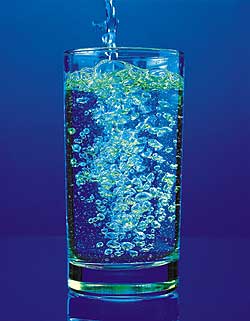99% of living matter consists of just four elements: carbon, hydrogen, oxygen and nitrogen because living things contain large quantities of water. Carbon combined with hydrogen and oxygen forms carbohydrates and lipids. The element nitrogen is combined with carbon, hydrogen and oxygen in compounds called amino acids from which proteins are constructed.
3.1.2 State that a variety of other elements are needed by living organisms, including sulfur, calcium, phosphorus, iron and sodium.
Sulfur
Calcium
Phosphorus
Sodium
3.1.3 State one role for each of the elements mentioned in 3.1.2
Sulphur
In plants, animals and prokaryotes
- In some amino acids and proteins
- In some vitamins
Calcium
In plants
- Cell wall formation between dividing plant cells
- co-factor for certain enzymes
- Constituent of bones
- reacts in muscle fibre contraction, blood clotting and synapse
- co-factor for certain enzymes
In prokaryotes
- Co-factor for certain enzymes
- contributes to heat resistance of bacterial endospores
Phosphorus
In plants, animals or prokaryotes
- Synthesis of nucleotides
- ATP
- Constituent of bones (animals only)
Iron
In plants, animals or prokaryotes
- Constituent of electron transport molecules
- Chlorophyll synthesis (In plants and prokaryotes only)
Sodium
In plants, animals or prokaryotes
- Involved with potassium in membrane function
- Nerve impulse transport (animals only)
3.1.4 Draw and label a diagram showing the structure of water molecules to show their polarity and hydrogen bond formation.
The hydrogen ions atom has a strong positive charge to other electron lone pairs. It creates a hydrogen bond which is an electrostatic attraction between the positively charged region of one water molecule and the negatively charged region of a neighbouring one.
3.1.5 Outline the thermal, cohesive and solvent properties of water.
Thermal properties of water
Heat energy and temperature of water requires a lot of energy to raise the temperature of water. This is because much energy is needed to break the hydrogen bonds that restrict the movements of water molecules. The specific heat capacity is high
Evaporation and heat loss and the amount of energy is the high latent heat of vaporisation. The evaporation of water in sweat on the skin, or in transpiration from green leaves. This leaves the surface very cool.
Heat energy and freezing requires a high amount of energy which is the latent heat of fusion. As a result, both the content of cells and the water in the environment are always slow to freeze in extreme cold.
The density of ice is lower than water hence ice floats. This allows aquatic life to survive below the ice.
Cohesive properties of water
Cohesion is the force by which individual molecules stick together. Water molecules tick together as a result of hydrogen bonding. Adhesion is the force by which individual molecules cling to surrounding materials and surface. Materials with an affinity for water are describe as hydrophilic. The outermost molecules of water form hydrogen bonds with the water molecules below them which creates the property of surface tension.
Below the surface, water molecules slide past each other very easily. This property is described as low viscoity.
Solvent properties of water
Water is a powerful solvent for polar substances. Ionic substance, cations and anions become surrounded by a shell of oriented water molecules. Carbon-containing (organic) molecules with ionised groups (such as the carboxyl group -COO- and the amino group -NH3+). Soluble organic molecules like sugar dissolve in water due to the formation of hydrogen bonds with their slightly charged hydroxyl groups (-OH).
3.1.6 Explain the relationship between the properties of water and its uses in living organisms as a coolant, medium for metabolic reactions and transport medium.
A liquid at room temperature, water dissolves more substances than any other common liquid
- Liquid medium for living things and for the chemistry of life
Much heat energy needed to raise the temperature of water
- Aquatic environment slow to change temperature
- Bulky organisms have stable temperatures
Evaporation requires a great deal of heat
- Evaporation causes marked colling (much heat is lost by evaporation of a small quantity of water)
Much heat has to be removed before freezing occurs
- Cell contents and water in aquatic environments are slow to freeze in cold weather
Ice is at maximum density at 4°C
- Ice forms on the surface of water, insulating the water below and allowing much aquatic life to survive freezing
Surface water molecules orientate with hydrogen bonds formed inwards
- Water forms droplets and rolls off surface
- Certain animals exploit surface tension to move over water surface
Water molecules slide past each other easily (low viscosity)
- Water flows easily through narrow capillaries, and through tiny spaces (e.g. in soils, spaces in cell walls)
Water molecules adhere to surfaces
- Water adheres to walls of xylem vessels as it is drawn up the stem to the leaves, from the roots
Water column does not break or pull apart under tension
- Water can be lifted by forces applied at the top, and so can be drawn up xylem vessels of tree trunks by forces generated in the leaves
Water is transparent
- Aquatic plants can photosynthesis at some depth in water








沒有留言:
張貼留言